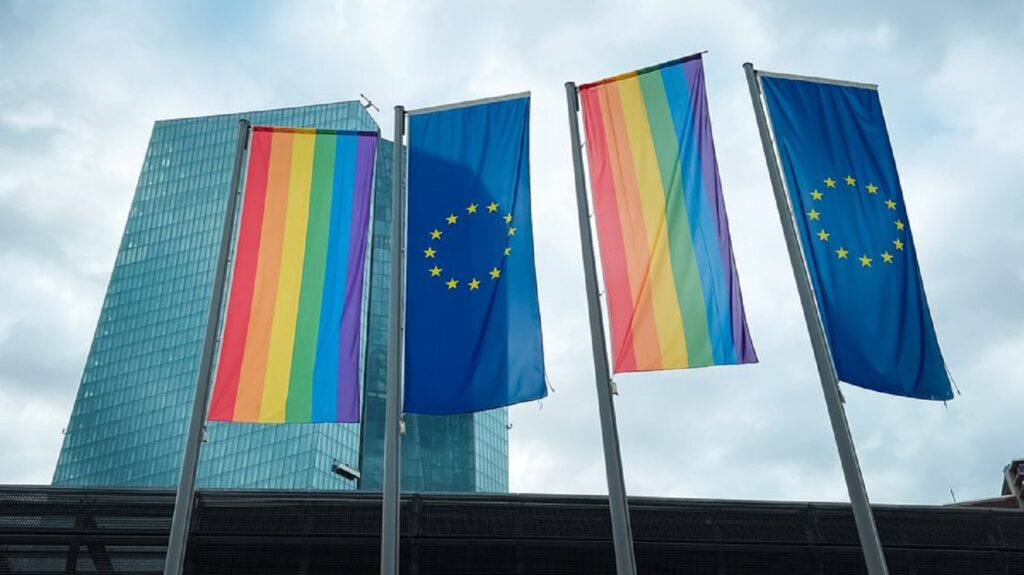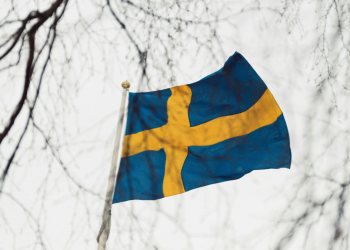At the end of 1918 the bolsheviks decriminalized homosexuality, and it became legal in the Soviet republics of Russia and Ukraine, but, interestingly, not in other Soviet republics, some of which even passed anti-homosexual laws during the 1920s. Until 1933, homosexuality remained a legal part of sexuality in these two republics, and as part of the overall restoration of the traditional family, in March 1934 Stalin amended the Criminal Code and re-criminalized homosexual behavior for men, introducing a prison term of up to five years.
“Destruction and resistance: Eastern Europe against the queer-communism of Brussels” is the title of Miša Đurković’s latest book, published by Catena Mundi, which deals with essential topics of our reality. The author continues and develops the themes and problems he dealt with in his previous books “The Right-Wing Thought in the 20th Century” and “War for the family in Serbia”.
The first half of the book deals with anti-family ideologies: constitutional struggles over defining the family, conflicts over the ratification of the Istanbul Convention, the struggle for the rights of religious people, gender mainstreaming and transhumanism. The second part is devoted to the issues of international relations and the dialectic of external destruction, recognizing the mechanisms by which it is done and maturing the awareness of the need for resistance. There are chapters on the transformation of international relations, when digitization and migration become geopolitical tools (weapons), then Orban and Kaczynski’s attempts to build alliances in the West, an analysis of the influence of external factors in the process of breaking up of Yugoslavia, as well as two chapters on the fate of Serbia. One is related to the outcome of the events on 5 October 2000, made 30 years after the introduction of pluralism and 20 years after the changes of October 5th, and another one shows how Brussels is directly the most responsible for the suppression of political pluralism, the rule of law, liberal democracy and all those truly Western or European values in which we once believed as victims of communism.
Đurković proves that Brussels directly destroyed every attempt to build a liberal-democratic society based on the rule of law, free enterprise and the anti-monopoly system on a value and practical level. Even their discourse is changing in the direction of authoritarianism and a kind of neo-communism, which, above all in the academic world, takes the form of brutal totalitarianism. The topic of our conversation is – how did we get to this point? How did queer-communism come after the communism of Lenin and Trotsky?
The basic thesis of your book is that queer-communism came to Eastern Europe as a substitute for traditional communism. What is this about?
– The Eastern Europeans were shocked by the value system and ideology that they found to be dominant and actually the prevalent in the European Union. The ideals of the rule of law, legal equality, general freedom, protection of the private sphere, freedom of religion, decency, morality, non-ideological education, constructive nationalism and others that they fantasized about were rapidly disappearing and were being replaced by a strange combination of values and ideologies in which those who were a little older and more ideologically intelligent easily recognized Trotskyism, which, admittedly, passed itself off as “liberalism”.
People like Klaus, who were educated on dissident anti-communist literature and the classics of the Western liberal thought, were disgusted by attempts to present this new body of anti-values as liberalism. As if it wasn’t enough that foreign corporations mostly tried to establish monopolies in these areas, the entire educational system was starting to follow the orders of feminism and LGBT ideology.
This new paradigm turned out to be far more dangerous than the old communism, for all that Eastern Europeans cared about. First of all, they were taught that the era of sovereignty and nation-states had passed at the moment when they hoped to finally get their own free nation-states. Then they explained to them that Christianity is outmoded, outdated, that it stands in the way of real modernization and emancipation, and that it too must modernize within itself and accept new values, which is what the churches in the West have been increasingly doing.
By opening their labor markets to millions of Eastern Europeans, they siphoned away large parts of the population, mostly young, vital and educated, thus emptying large parts of their home countries. Other processes that they encouraged legally led to the centralization and pooling of capital, as well as the population in a single large center. At the same time, through education reforms, the legal framework, and popular culture they promoted an ideology that denies the birth and value of human life, and as a result, in three decades, many of the mentioned countries found themselves largely emptied of their population and thus open to the invasion of immigrants. In 2015, they saw that Brussels wanted exactly that, to settle on their empty territories millions of immigrants who come from completely different climates, cultures and religions.
When it comes to the destruction of a family, it is a long-term process. It seemed impossible to destroy it, but we have come to the point when the collapse of the pro-family West is looming on the horizon. How did the “long march” of anti-family forces unfold?
– Today it has already become a common place in conservative circles to quote Gramsci’s famous explanation of the failure of the communist revolution in Italy and in the West. As is well known, in his “Prison Notebooks” he pointed out the fact that the entire Western world has been deeply soaked with two millennia of Christianity. Therefore, all social institutions, phenomena and, above all, the general cultural and value atmosphere were then founded and colored by the Christian religion. Of course, all this was reflected and refracted in the family.

The traditional, patriarchal family with many children was the basis of Western societies and civilization. It was a union of a man and a woman intended for the birth and upbringing of children, connected by faith, love and mutual respect, included in a wider religious, social, and later state community. At the same time, the family was also the basic economic unit, since almost until the 20th century, most of the production and economic activities were carried out under the auspices of the family household.
The Western tradition included respecting the family as a sphere of privacy in which the state should not interfere. The man represented the family in the public sphere and was in charge of feeding and providing for the family, while the woman was the basis of the inner life in the house, taking care of children, nutrition and the general organization of family life in the house. For a long time, the family home was a distinctly functional place in which not only one lived, but also performed numerous tasks, from farming, to educating children, to caring for the elderly, etc. The woman was in a financially and legally subordinate position, but she was dominant in the functions and roles she assumed. This system had the quality of encouraging spouses to solve their problems by themselves and to develop mutual relations as a separate universe, while today the tendency is for the state to interfere in family relations in every way and to try to dictate and regulate them.
Yet the family seemed to resist, despite the coup d’état of the anti-Christian elites?
– Even at a time when the process of so-called female emancipation was being rolled out and when women received various public and political rights, the traditional family model survived as long as factual Christian morality was maintained and transmitted as a value system through different pores of society. This is evidenced by e.g. the clear resistance of the people in the USSR (especially in the countryside) to the new systems introduced after the October Revolution, as well as significant periodic waves of renewed birthing of children, as a rule, closely related to the renewal of the importance of religiosity in the public sphere, as it was in America in the 1940s and 1950s.
The family, it should be emphasized, was also understood as the basic economic unit of society: an institution that primarily funds economic relations and economic ethics, from primogeniture and cooperatives to private enterprises – as a space in which a child learns to manage funds, to work and help, to plan, and to acquire an awareness of duties, management, solidarity, etc. During the last two and a half centuries, however, this model has become the subject of direct attacks by various involved ideologies, movements and actors. Therefore, almost all forms of conservative and right-wing thought during that period placed the preservation of the traditional family at the center of their interests and programs. Religion and the institution of the family (along with issues of value, authority and morality) are essentially the two main subjects of contention in the modern age.
In the book “Libido Dominandi: Sexual Liberation and Political Control”, the American cultural scientist Michael Jones argues that occult quasi-elites began to destroy the family after the French Revolution and that the process continues today. He believes that this was done because the family is the last defense of the common man against the totalitarian control of the state, which has passed under the control of the globalist revolutionaries. What is your opinion on that?
– The French bourgeois revolution is the first major political event in modern history in which marriage was planned to be placed at the center of politics. In her excellent book “The Family at Court in Revolutionary France”, Susan Dessan proved with a lot of arguments and data precisely the thesis that the politicization and reform of the institution of marriage was one of the key goals of the revolutionaries.
Indeed, in contemporary literature on the development of family relations and family law, this period is studied as the beginning of modern family reform. Namely, the new political forces for the first time practically promoted and applied a whole series of innovations such as no-fault divorce, the abolition of primogeniture in inheritance, i.e. the introduction of equal distribution of inheritance between children, the establishment of women’s special rights and gender equality, the equalization of the status of legitimate (children born in a legal marriage) and illegitimate (out of wedlock) children. In September 1792, a law was passed which at the same time introduced civil marriage and civil keeping of marriage records, then legalized divorce, lowered the age limit of young people entering adulthood and introduced a ban on parents influencing the choice of a spouse for their children.
Leftist ideologies and movements continued to dismantle the traditional family. In which direction did it go?
– Let us first list the various forms of communist and anarchist ideology. Consistently performed in their normative ideal of society, it is about completely free love, discontinuous current relationships, and the transfer of care and custody of children to the entire community.
Of course, within these movements there were many variations, so with Proudhon there is still a place for the traditional family and the privileged position of men. But with Bakunin, for example, the disintegration of the family as a bourgeois tyrannical shackle was complete. The most important writing in this tradition is Engels’ “Origin of the Family, Private Property and the State” published in 1884 .
It is followed by left liberalism and social democracy. These are more moderate variants of the left tradition, but with very similar normative goals – encouraging women to enter the labor market, to specialize and create a career, as well as the development of a collective welfare state in which children are transferred to the state to be raised in state institutions, and the traditional family is deprived of almost all of its functions and is deconstructed.
And what about feminism? How did it turn into a movement whose enemy is the family?
– During the 19th century, feminism was mostly linked to the liberal tradition, demanding the gradual emancipation of women, their education and the acquisition of certain rights. However, in the 20th century this ideology took radical forms and aligned itself with radical and communist movements, directly undermining the public/private distinction. Contemporary feminism is a distinctly anti-family ideology in which this institution is seen exclusively as a shackle that hinders the liberation and development of women.
And so we came to what you call “queer-communism”. What are its beginnings and what are its goals?
– Homosexual movements and queer ideologies are the next enemy of the family. This tradition calls for the equalization of same-sex unions with the classic family, the acquisition of all family rights for them, including the possibility of adoption and surrogate motherhood as a way to have offspring.
But “queer ideology” has long since given up seeking rights only for those who are “different”. The declared goal is the universalization of such practices, that is, movement towards a society in which all citizens would practice unstable, dynamic, flexible sexual and gender identities. The traditional family, defined as the marriage between a woman and a man, understandably represents the biggest obstacle in the realization of such efforts.
Why are occult quasi-elites interested in such developments?
– The interests of big capital (banks and large corporations) often coincide with some or all of the above groups, so they mainly use their resources (money, media, lobbying) to promote and implement their ideas. It is an effort to form an androgynous, replaceable person, an individual focused on a career, unrooted and unattached to the family.
The family, which is the basis of some calmness and security, prevents the consistent introduction of all citizens and workers into the so-called state of shock (Alvin Toffler). However, we should not lose sight of the geopolitical dimension either: certain foreign powers can weaken competing states through such ideas, ideologies and movements (correlation with the decline in birth rates, internal homogeneity, stability, orderliness of life, etc.).

The imposition of anti-family ideologies in practice leads to the destruction of the entire society: fewer marriages, more divorces, fewer children, introduction of anarchy into family relations, reduction of the population, all of which leads to a decline in the overall strength and potential of the state in the international sphere. Alan Carlson in his “Torn Generations” gives an excellent example, the official US document, NSSM 200 from 1974, prepared by Henry Kissinger. In it, Kissinger defined that the USA will in all possible ways encourage the stopping of population growth, i.e. its decline in 13 countries.
Let’s go back to the story of communism. Many believe that the sexual revolution is “permanent”, as Trotsky envisioned it, and that the Western “queer communists” are in fact the new Trotskyists.
– Lenin, Trotsky and their collaborators took Engels’ instructions seriously and began a program of radical destruction of inherited family relationships, along with the abolition of religion and private property. Already in December 1917, the Council of People’s Commissars issued a decree that made it easier to get a divorce. But that was only the beginning of the introduction of a large package of measures, which until the 1930s created complete chaos in the new Soviet society.
In the article Communism and the Family from 1920, Aleksandra Kollontai welcomes the mass exodus of women to work in industry and says that it is quite natural that as a result family ties should begin to weaken. Furthermore: “The circumstances that previously held the family together no longer exist. The family ceases to be indispensable both to its members and to the nation as a whole.”
In this Marxist classic, Kollontai explains to women that they no longer have the right to any special sensitivity towards their children. A proletarian woman must learn that there is no difference between my children and yours, that is, that we all have to care equally for all our children, and that instead of one family today, we should care for the big proletarian family of the whole of Russia. The key to this program is that work in the home ceases to be necessary, because the state takes over the collective, industrial performance of all these functions, and the care and education of children must also leave the family home, since the state will do it better.
What consequences did it have in Soviet society?
– In the excellent book “Everyday Stalinism”, Sheila Fitzpatrick devoted a special chapter to family problems in Soviet Russia in the period between the revolution and the Second World War. A special chapter in the Trotskyist classic “The Revolution Betrayed”, which Trotsky dedicated to “Thermidor” in the family, youth and culture, is very important for understanding this problem.
By showing how Stalin implements the restoration of conservative and traditional models in the family, he clearly revives the former goals of Bolshevik activity in the field of family relations. In this piece, Trotsky describes with joy and enthusiasm the “heroic era” in which they made an “assault on the old family”. He repeats the claim about the woman as a forced laborer who should be freed from the shackles of the family economy and sent to the labor market.
Fitzpatrick shows that in the 1930s, tens of millions of women suddenly entered the state labor system, which caused incalculable social consequences and an abundance of pathology. Kollontai, Karl Radek and others initiated a whole series of radical measures for the overall social change of the atmosphere, which in principle amounted to the abolition of decency, civilization, restraint, chastity and civic and traditional morality. In his diaries from 1924, Bulgakov describes one of the numerous marches organized by the movement called “Down with shame!” (Долой стыд!). They rode trams naked in broad daylight, e.g., publicly propagating free love and naked bodies.
So you think that before the queer revolution there was a Bolshevik sexual revolution?
– It should be noted that at the end of 1918 the Bolsheviks also decriminalized homosexuality, so that it became legal in the Soviet republics of Russia and Ukraine, but interestingly – not in other Soviet republics, some of which passed laws against homosexuals during the 1920s. Until 1933, homosexuality remained a legal part of sexuality in these two republics, and as part of the overall restoration of the traditional family, in March 1934 Stalin amended the Criminal Code and re-criminalized homosexual behavior for men, introducing a prison term of up to five years. It is interesting that in Stalin’s time homosexuality was attributed to fascism and tsarist decadence.




















Discussion about this post